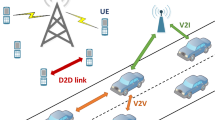Abstract
In this paper, we introduce a message physical layer assisted message authentication (PAA) framework under public key infrastructure (PKI) in vehicular communication networks. The proposed framework takes advantage of temporal and spatial uniqueness in physical layer channel responses for each transmission pair, in which a trust between two vehicles can be maintained by comparing the current estimated channel response and the previous estimated channel response. We will show that the proposed message authentication framework can achieve high efficiency and minimal authentication delay without compromising the security requirements, which is further verified through both analysis and simulation.
Similar content being viewed by others
References
Task Group p. IEEE P802.11p: Draft standard for information technology telecommunications and information exchange between systems local and metropolitan area networks specific requirements, Part 11: Wireless LAN medium access control (MAC) and physical layer (PHY) specifications. USA IEEE Computer Society, 2009
Hubaux J P. The security and privacy of smart vehicles. IEEE Secur Priv, 2004, 2: 49–55
Raya M, Hubaux J P. Securing vehicular ad hoc networks. J Comput Secur, 2007, 15: 39–68
Dotzer F. Privacy issues in vehicular ad hoc networks. In: Proceeding of ACM Workshop on Vehicular Ad Hoc Networks, Los Angeles, California, USA, 2006. 45–52
Moustafa H, Bourdon G, Gourhant Y. AAA in vehicular communication on highways with ad hoc networking support: a proposed architecture. In: Proceeding of ACM Workshop on Vehicular Ad hoc Networks, Cologne, Germany, 2005. 79–80
Zhang C, Lu R, Lin X, et al. An efficient identity-based batch verification scheme for vehicular sensor networks. In: Proceeding of IEEE Infocom, Phoenix, AZ, USA, 2008. 246–250
Lin X D, Sun X T, Wang X Y, et al. TSVC: Timed efficient and secure vehicular communications with privacy preserving. IEEE Trans Wirel Commun, 2009, 7: 4987–4998
Hero A O. Secure space-time communication. IEEE Trans Inf Theory, 2003, 49: 3235–3249
Li X H, Hwu J. Using antenna array redundancy and channel diversity for secure wireless transmissions. J Commun, 2007, 2: 24–32
Nloch M, Barros J, Rodrigues M R D. Wireless information theoretic security. IEEE Trans Inf Theory, 2008, 54: 2515–2534
Xiao L, Greenstein L, Mandayam N, et al. Using the physical layer for wireless authentication in time-variant channels. IEEE Trans Wirel Commun, 2008, 7: 2571–2579
Xiao L, Greenstein L, Mandayam N, et al. A physical-layer technique to enhance authentication for mobile terminals. In: Proceeding of IEEE International Conference on Communications, Beijing, China, 2008. 1520–1524
Hu Z Y, Sun FC, Jiang J C. Ciphertext verification security of symmetric encryption schemes. Sci China Ser F-Inf Sci, 2009, 52: 1617–1631
Wang S B, Cao Z F, Cheng Z H, et al. Perfect forward secure identity-based authenticated key agreement protocol in the escrow mode. Sci China Ser F-Inf Sci, 2009, 52: 1358–1370
Edfors O, Sandell M, Van J J, et al. OFDM channel estimation by singular value decomposition. IEEE Trans Commun, 1998, 46: 931–939
Hoeher P, Kaiser S, Robertson P. Pilot-symbol-aided channel estimation in time and frequency. In: Proceeding of IEEE Global Telecommunication, Arizons, USA, 1997. 90–96
Li Y, Cimini Leonard J. Robust channel estimation for OFDM systems with rapid dispersive fading channels. IEEE Trans Commun, 1998, 46: 902–915
Author information
Authors and Affiliations
Corresponding author
Rights and permissions
About this article
Cite this article
Wen, H., Ho, P. & Gong, G. A framework of physical layer technique assisted authentication for vehicular communication networks. Sci. China Inf. Sci. 53, 1996–2004 (2010). https://doi.org/10.1007/s11432-010-4065-y
Received:
Accepted:
Published:
Issue Date:
DOI: https://doi.org/10.1007/s11432-010-4065-y




